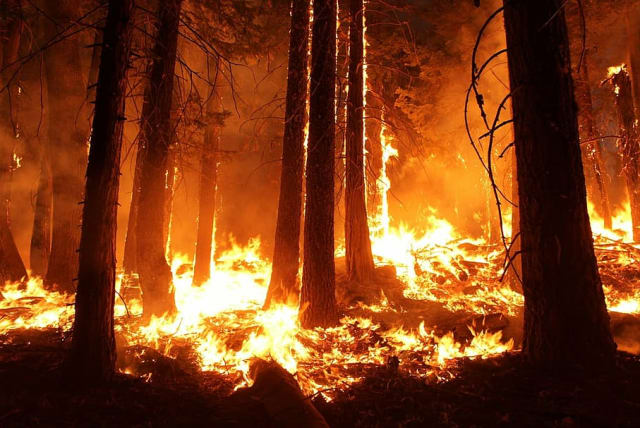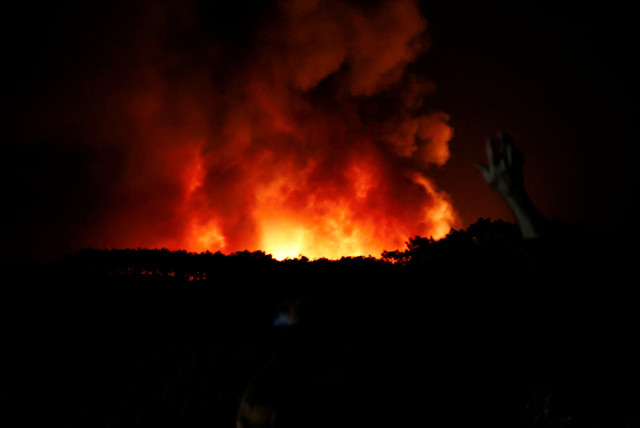Scientists fear death by wildfires that wiped out ancient mammals

Thirteen millennia ago, a torrent of wildfires swept across California.
Could all-consuming wildfires sparked by ancient climate change and human negligence have caused the extinction of thousands of species of large mammals over 13,000 years ago?
New research by a team of California scientists suggests that the answer is yes, and they draw a dangerous parallel between then and now.
Among the myriad chapters of our planet's past, the late Ice Age (Pleistocene era) stands out as a time of profound ecological upheaval, marked by the disappearance of numerous large mammals (megafauna) from diverse regions worldwide.
The cause of this wave of extinctions has long been a subject of intense scientific discourse, with global warming and human interventions emerging as leading contenders.
Yet one phenomenon has been largely ignored. Thirteen millennia ago, a torrent of wildfires swept across California.
In their latest research, published this month in Science, American scholar F. Robin O'Keefe and team used fossil records at California's La Brea tar pits to prove a connection between increased wildfires and the extinction of these large mammals.
According to their report, the Americas and Eurasia teemed with enormous beasts during most of the Ice Age. The great extinction resulted in the loss of more than 70% of mammals in North America that weighed more than 44 kilograms and as many as 90% in Australia.
"At the end of the Pleistocene, most of Earth's large mammals became extinct," the authors wrote in their introduction. "These extinctions occurred at different times globally, resulting in a drastic reorganization of terrestrial ecosystems.
"Despite decades of research on extinction causality, the relative importance of late-Quaternary climate changes and spreading human impacts have been difficult to disentangle because poor chronological resolution in the fossil record has precluded alignment of these rapidly occurring, tightly linked phenomena,” they further explained.
However, the researchers found that some records could offer clues.
They turned to the La Brea Tar Pits in Los Angeles, the world's most extensive collection of ice age fossils. The site's naturally occurring asphalt seeps entrapped and preserved the bones of large mammals from the 50,000 years of the Ice Age - most with their original collagen. The scientists were able to use modern radioactive carbon dating technology to shed new insight into the timing and causes of collapse of the ancient ecosystem.
Specifically, they obtained dates on 172 specimens from seven extinct and one extant species: sabertoothed cat, dire wolf, coyote, American lion, ancient bison, western horse, Harland's ground sloth and yesterday's camel - all of which died off between 10,000 and 15,000 years ago.
"To investigate the potential roles of late-Quaternary environmental change and human activities in driving the observed patterns, we compared our analyses of population structure and megafaunal extirpation against well-resolved regional and continental paleoclimatic proxies, vegetation records, and modeled human demographic growth," the authors explained in their abstract. "We used time-series modeling to investigate the dynamics of ecosystem change and evaluate causal relationships among these different phenomena."
The modeling found that most large mammals disappeared with a regional ecological shift, including drastically increasing fires.
Now, the scientists have raised a red flag
"The processes that led to this collapse are familiar today," warned co-authors and California-based researchers Emily Lindsey, Lisa N. Martinez, and Regan E. Dunn explained in an open-source article on their paper published on The Conversation website.
California warmed by as much as 5.5 degrees Celcius. Then, the ecosystem entered a 200-year-long drought, which led the trees to dry up. At the same time, the human population expanded in the region, and the people lit fires.
"Humans and our ancestors have used fire for hundreds of thousands of years, but fire has different impacts in different ecosystems. Charcoal records from Lake Elsinore reveal that before humans, fire activity was low in coastal Southern California," the researchers said in their article. "But 13,200 to 13,000 years ago, as human populations grew, fire in the region increased by an order of magnitude.
"Our data document a transition from a postglacial megafaunal woodland to a human-mediated chaparral ecosystem in Southern California before the onset of the Younger Dryas," they continued. "This transition began with gradual opening and drying of the landscape over two millennia and terminated in an abrupt (300-year) regime shift characterized by the complete extirpation of megafauna and unprecedented fire activity. This state shift appears to have been triggered by human-ignited fires in an ecosystem stressed by rapid warming, a megadrought, and a millennial-scale trend toward the loss of large herbivores from the landscape. This event parallels processes occurring in Mediterranean ecosystems today."
They said that by studying what caused extinction at the end of the Ice Age in California, scientists can contextualize the potential impact of today's climate and biodiversity crises.
"The alarming difference is that temperatures today are rising 10 times faster than they did at the end of the ice age, primarily because of the burning of fossil fuels," Lindsey, Martinez and Dunn said. "This human-caused climate change has contributed to a fivefold increase in fire frequency and intensity and the amount of area burned in the state of California in the past 45 years."
A separate report by the University of California found more than 3,350 fires in 2009 and 2018 in California, 1.4 times more than the per-decade average number of fires between 1979 and 2009.
Most of those fires were caused not only by highly flammable dry grasses, shrubs, and pine needles but by human activities, such as downed power lines, campfires, and more, according to reports.
Lindsey, Martinez, and Dunn said that “the past teaches us that the ecosystems we depend upon are vulnerable to collapse when stressed by multiple intersecting pressures.”
As such, they said, "redoubling efforts to eliminate greenhouse gas emissions, prevent reckless fire ignitions and preserve Earth's remaining megafauna can help avert another, even more catastrophic transformation."
The Environment and Climate Change portal is produced in cooperation with the Goldman Sonnenfeldt School of Sustainability and Climate Change at Ben-Gurion University of the Negev. The Jerusalem Post maintains all editorial decisions related to the content.
Jerusalem Post Store
`; document.getElementById("linkPremium").innerHTML = cont; var divWithLink = document.getElementById("premium-link"); if (divWithLink !== null && divWithLink !== 'undefined') { divWithLink.style.border = "solid 1px #cb0f3e"; divWithLink.style.textAlign = "center"; divWithLink.style.marginBottom = "15px"; divWithLink.style.marginTop = "15px"; divWithLink.style.width = "100%"; divWithLink.style.backgroundColor = "#122952"; divWithLink.style.color = "#ffffff"; divWithLink.style.lineHeight = "1.5"; } } (function (v, i) { });

